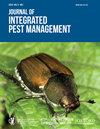三叶草Curculio的生物学与管理(鞘翅目:Curculionidae)
IF 2.7
3区 农林科学
Q1 ENTOMOLOGY
引用次数: 6
摘要
随着呋喃、甲基溴和其他人工土壤熏蒸剂的逐步淘汰,三叶草根curculio (Sitona hispidulus (F.)) (CRC)已成为苜蓿的重要经济害虫。CRC原产于温带的欧洲、中东和亚洲,在20世纪初被引入北美,现在在美国广泛存在。然而,幼虫对根系的严重伤害会导致植物次生病原体感染,导致饲料质量、产量和林分寿命的损失。监测工作包括对成虫进行扫网,对植物树冠和根部周围的土壤进行取样,寻找虫卵和幼虫。结直肠癌密度与根系损害以及经济阈值之间的关系尚未建立。虽然有几种拟除虫菊酯已被登记用于结直肠癌成人,但由于潜在的非靶效应,不推荐使用。化学控制尚未登记用于防治隐幼虫阶段。本文就结直肠癌的鉴别、生活史、生物学和生态学进行综述。潜在的生态管理策略(如作物轮作、种植日期、抗性寄主品种)、生物防治剂和杀虫剂选择也被描述为针对美国紫花苜蓿结直肠癌的综合虫害管理计划的关键组成部分。本文章由计算机程序翻译,如有差异,请以英文原文为准。
Biology and Management of Clover Root Curculio (Coleoptera: Curculionidae)
Clover root curculio (Sitona hispidulus (F.)) (CRC) has become an economically important pest of alfalfa since the regulatory phase-out of carbofuran, methyl bromide, and other synthetic soil fumigants. Native to temperate Europe, the Middle East, and Asia, CRC was introduced to North America in the early 1900s and is now widespread across the U.S. Adult foliar herbivory is not typically economically important. However, severe root damage by larvae can result in secondary plant pathogen infections, leading to losses in forage quality, yield, and stand life. Monitoring efforts include sweep netting adults and soil sampling around the crown and roots of plants for eggs and larvae. Relationships between CRC densities and root damage as well as economic thresholds have yet to be established. Although several pyrethroids have been registered for use against CRC adults, they are not recommended due to potential non-target effects. Chemical controls have not been registered for use against the cryptic larval stage. This review discusses CRC identification, life history, biology, and ecology. Potential ecological management strategies (e.g., crop rotation, planting dates, resistant host varieties), biological control agents, and insecticide options are also described as key components of an integrated pest management program against CRC in U.S. alfalfa.
求助全文
通过发布文献求助,成功后即可免费获取论文全文。
去求助
来源期刊

Journal of Integrated Pest Management
Agricultural and Biological Sciences-Insect Science
CiteScore
5.80
自引率
3.60%
发文量
24
审稿时长
25 weeks
期刊介绍:
Journal of Integrated Pest Management is an open access, peer-reviewed, extension journal covering the field of integrated pest management. The Editors-in-Chief are Dr. Marlin E. Rice (formerly with Iowa State University) and Dr. Kevin L. Steffey (formerly with the University of Illinois). The journal is multi-disciplinary in scope, publishing articles in all pest management disciplines, including entomology, nematology, plant pathology, weed science, and other subject areas.
 求助内容:
求助内容: 应助结果提醒方式:
应助结果提醒方式:


